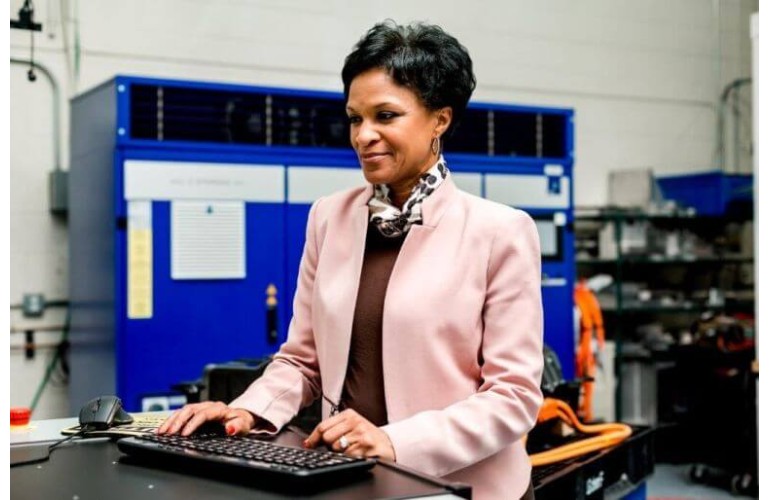 Subscribe
Subscribe- Login
-
/
Sign Up
- US Black Engineer
- >>
- News
- >>
- Denise Gray: A Female CEO You Should Know
Denise Gray is known as the “battery czar” in some circles. And here’s why. She once ran the world that power your vehicles and keep electric cars supplied with new automotive batteries.
By all accounts, Gray is still running things and making gains.
In October 2015, LG Chem Power Inc. announced Gray would be stepping in as CEO. For industry insiders, it was simply the right decision to select Gray to head up LG Chem Power Inc., the North American subsidiary of LG Chem Ltd.
LG Chem is one of the world’s largest maker and suppliers of automotive battery for electric vehicles, such as the Ford Focus and Chevrolet Volt.
Before joining LG Chem Power, Gray built an impressive track record in vehicle electrification.
Gray’s job at General Motors was overseeing GM’s efforts to develop new batteries for electric vehicles.
That involved picking the right lithium-ion system, ensuring battery packs were tested, navigating government safety-certification requirements in many countries around the world, and having the packs manufactured to meet global quality standards.
She also had two years to get the job done.
Gray and her team, working closely with LG Chem, developed and launched the lithium-ion battery system that powered the original Chevrolet Volt.
Building Blocks of Success
“My work builds on itself,” Gray said. “What I do now is approximately what I’ve done for the past fifteen years. Electric powertrain technology has moved very aggressively, and we have had to move as fast as we can,” she noted.
Since Gray took over as chief executive of LG Chem Power, its battery systems have been selected to power an impressive array of cutting-edge vehicles, including the Chevrolet Bolt and Chrysler Pacifica hybrid-electric vehicles.
“We believe our technical strengths [and] engineering and manufacturing expertise position us as a leading battery and control system provider for electric vehicles today and in the future,” Gray said.
“Our experience with entire battery packs, including cell design and manufacturing capability, and our expertise in vehicle integration, makes us the ideal battery supplier for the Pacifica Hybrid as well as others,” she said.
Tech, Engineering, and Manufacturing Expertise
Gray encourages young people interested in science, technology, engineering, and math (STEM) to learn the skills needed to develop battery and control systems because demand will continue to increase.
“The battery is a multi-disciplinary product, and putting it together takes specialists from different types of engineering,” she said.
Gray’s teams have included electrical engineers, chemical engineers, mechanical engineers, and people skilled in electronics hardware, software, and controls design.
“Industry is always going to need people who can innovate,” she said. “The technology we have today wasn’t here when our parents were young. We Americans love to be the first at doing something. Innovation is a part of our core.”
‘Battery Czar’
A graduate of Kettering University in Flint, Mich., she was named to the university’s Co-op Hall of Fame in 2009. Her co-op experience at Kettering exposed her to a five-year rotation in electrical test labs, vehicle assembly plants, prototype manufacturing shops, and software design, all of which helped her gain valuable experience and expertise.
That training helped her develop a vision for what she wanted to accomplish at GM.
“I wanted to be the best entry-level engineer that I could be and, from there, continue to contribute great ideas and innovation as a senior engineer,” she said.
After years on the job, Gray found that the manufacturing industry needed managers who were good communicators and people oriented in order to bring a product to market.
“It took some courage,” she admitted, “but I found that I’d progressed toward leadership. It was a natural evolution. I wasn’t fighting it.”
Gray’s rise from graduate to her first managerial position was spread over more than a decade. Working on the Volt program from 2006–2010 exposed her to decision making at the highest level.
“The Volt program was a collaboration of suppliers and OEMs. We were creating capital as we were building a product that didn’t have a market. It was new; it was different,” she explained.
At GM, Gray had global responsibility and oversight of GM’s hybrid battery development efforts. She also served as director of transmission controls and director of engine and transmission software and control systems integration.
Gray comes from a long line of auto workers. Growing up in Detroit, Michigan, in the 1960s and 70s, her “entire family worked in the industry,” she told IEEE in the summer of 2008.
“My aunt assembled V6 engines at GM’s Livonia engine plant; my other aunt and my uncles assembled axles at GM Gear & Axle. Working for auto companies was just a part of our life.” Her mother worked at GM too, making stabilizer bars and other parts in a General Motors forge plant—some of the hottest and most grueling work in the industry. Still, even though cars were in her blood, Gray didn’t own one when she first started working at GM in 1980; she rode the city bus to her position in Warren, Mich., at the GM Technical Center.
Gray and her husband, a retired GM executive, have been married for 30 years. The couple has two sons, 27 and 23. Both trained in engineering and program management.
“Faith in God, family, and work is all we’ve ever had,” she said.


 Denise Gray is known as the “battery czar” in some circles. And here’s why. She once ran the world that power your vehicles and keep electric cars supplied with new automotive batteries.
Denise Gray is known as the “battery czar” in some circles. And here’s why. She once ran the world that power your vehicles and keep electric cars supplied with new automotive batteries.
Calvin FlowersJuly 24, 2018
5:07 pm
To Whom It May Concern:
I am the President of the Chicago Inventors Organization and I would like to know if you can put me in touch with Denise Gray? I can be reached at 312-850-4710 and our website is http://www.chicago-inventors.org.
Thank you,
Calvin Flowers